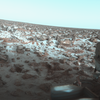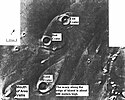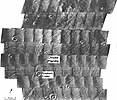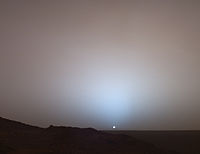Exploration of Mars: Difference between revisions
→NASA: Boeing mission tentative selection |
→NASA: fix title |
||
| Line 326: | Line 326: | ||
Human exploration by the United States was identified as a long-term goal in the [[Vision for Space Exploration]] announced in 2004 by then US President [[George W. Bush]].<ref name=britt_bush_vision/> The planned ''[[Orion (Constellation program)|Orion]]'' spacecraft would be used to send a human expedition to Earth's moon by 2020 as a stepping stone to a Mars expedition. On September 28, 2007, NASA administrator [[Michael D. Griffin]] stated that NASA aims to put a person on Mars by 2037.<ref name=mars_daily/> |
Human exploration by the United States was identified as a long-term goal in the [[Vision for Space Exploration]] announced in 2004 by then US President [[George W. Bush]].<ref name=britt_bush_vision/> The planned ''[[Orion (Constellation program)|Orion]]'' spacecraft would be used to send a human expedition to Earth's moon by 2020 as a stepping stone to a Mars expedition. On September 28, 2007, NASA administrator [[Michael D. Griffin]] stated that NASA aims to put a person on Mars by 2037.<ref name=mars_daily/> |
||
On December 2, 2014, NASA's Advanced Exploration Systems |
On December 2, 2014, NASA's Advanced Human Exploration Systems and Operations Mission Director Jason Crusan and Deputy Associate Administrator for Programs James Reuthner announced tentative support for the [[Boeing]] "Affordable Mars Mission Design" including radiation shielding, centrifugal artificial gravity, in-transit consumable resupply, and a lander which can return.<ref>http://www.hou.usra.edu/meetings/lpsc2014/eposter/2258</ref><ref>https://www.dropbox.com/s/0gagd1dbyptnvwg/Raftery_05-14-14.pdf</ref> Reuthner suggested that if adequate funding was forthcoming, the proposed mission would be expected in the early 2030s.<ref>https://www.youtube.com/watch?v=zBoj-1m-qLU&ab_channel=NASA</ref> |
||
===Zubrin=== |
===Zubrin=== |
||
Revision as of 21:54, 11 March 2015

| Year |
|
|---|---|
| 2014 | |
| 2013 | |
| 2012 | |
| 2011 | |
| 2010 | |
| 2009 | |
| 2008 | |
| 2007 | |
| 2006 | |
| 2005 | |
| 2004 | |
| 2003 | |
| 2002 |
The exploration of Mars has taken place over hundreds of years, beginning in earnest with the invention and development of the telescope during the 1600s. Increasingly detailed views of the planet from Earth inspired speculation about its environment and possible life – even intelligent civilizations – that might be found there. Probes sent from Earth beginning in the late 20th century have yielded a dramatic increase in knowledge about the Martian system, focused primarily on understanding its geology and habitability potential.
Engineering interplanetary journeys is very complicated, so the exploration of Mars has experienced a high failure rate, especially in earlier attempts. Roughly two-thirds of all spacecraft destined for Mars failed before completing their missions, and there are some that failed before their observations could begin. However, missions have also met with unexpected levels of success, such as the twin Mars Exploration Rovers operating for years beyond their original mission specifications.
As of 24 September 2014, there are two scientific rovers on the surface of Mars beaming signals back to Earth (Opportunity of the Mars Exploration Rover mission, and Curiosity of the Mars Science Laboratory mission), and five orbiters currently surveying the planet: Mars Odyssey, Mars Express, Mars Reconnaissance Orbiter, Mangalyaan and MAVEN.
To date, no sample return missions have been attempted for Mars, and one attempted return mission for Mars' moon Phobos (Fobos-Grunt) has failed.
On 24 January 2014, NASA reported that current studies on the planet Mars by the Curiosity and Opportunity rovers will now be searching for evidence of ancient life, including a biosphere based on autotrophic, chemotrophic and/or chemolithoautotrophic microorganisms, as well as ancient water, including fluvio-lacustrine environments (plains related to ancient rivers or lakes) that may have been habitable.[1][2][3][4] The search for evidence of habitability, taphonomy (related to fossils), and organic carbon on the planet Mars is now a primary NASA objective.[1]
Recent missions
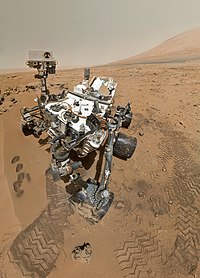
NASA's Mars Odyssey orbiter entered Mars orbit in 2001.[5] Odyssey's Gamma Ray Spectrometer detected significant amounts of hydrogen in the upper metre or so of regolith on Mars. This hydrogen is thought to be contained in large deposits of water ice.[6]
The Mars Express mission of the European Space Agency (ESA) reached Mars in 2003. It carried the Beagle 2 lander, which was not heard from after being released and was declared lost in February 2004. Beagle 2 was located in January 2015 by HiRise camera on NASA’s Mars Reconnaissance Orbiter (MRO) having landed safely but failed to fully deploy its solar panels and antenna.[7][8] In early 2004 the Mars Express Planetary Fourier Spectrometer team announced the orbiter had detected methane in the Martian atmosphere. ESA announced in June 2006 the discovery of aurorae on Mars.[9]
In January 2004, the NASA twin Mars Exploration Rovers named Spirit (MER-A) and Opportunity (MER-B) landed on the surface of Mars. Both have met or exceeded all their targets. Among the most significant scientific returns has been conclusive evidence that liquid water existed at some time in the past at both landing sites. Martian dust devils and windstorms have occasionally cleaned both rovers' solar panels, and thus increased their lifespan.[10] Spirit Rover (MER-A) was active until 2010, when it stopped sending data.
On March 10, 2006, the NASA Mars Reconnaissance Orbiter (MRO) probe arrived in orbit to conduct a two-year science survey. The orbiter began mapping the Martian terrain and weather to find suitable landing sites for upcoming lander missions. The MRO snapped the first image of a series of active avalanches near the planet's north pole, scientists said March 3, 2008.[11]
The Mars Science Laboratory mission was launched on November 26, 2011 and it delivered the Curiosity rover, on the surface of Mars on August 6, 2012 UTC. It is larger and more advanced than the Mars Exploration Rovers, with a velocity of up to 90 meters per hour (295 feet per hour).[12] Experiments include a laser chemical sampler that can deduce the make-up of rocks at a distance of 7 meters.[13]
The Indian Space Research Organization (ISRO) launched its Mars Orbiter Mission (MOM) on November 5, 2013. It was successfully inserted into Mars orbit on 24 September 2014. India's ISRO is the fourth space agency to reach Mars, after the Soviet space program, NASA and ESA.[14] India became the first country to successfully get a spacecraft into the Martian orbit on its maiden attempt.[15]
Martian system
Mars has long been the subject of human fascination. Early telescopic observations revealed color changes on the surface that were originally attributed to seasonal vegetation as well as apparent linear features that were ascribed to intelligent design. These early and erroneous interpretations led to widespread public interest in Mars. Further telescopic observations found Mars' two moons, Phobos and Deimos, the polar ice caps, and the feature now known as Olympus Mons, the solar system's tallest mountain.[16] These discoveries piqued further interest in the study and exploration of the red planet. Mars is a rocky planet, like Earth, that formed around the same time, yet with only half the diameter of Earth, and a far thinner atmosphere, it has a cold and desert-like surface. It is notable, however, that although the planet has only one quarter of the surface area of the Earth, it has about the same land area, since only one quarter of the surface area of the Earth is land.
Launch windows
| Year | Launch | Spacecraft (Launched or Planned) |
|---|---|---|
| 2013 | Nov 2013 | MAVEN, Mars Orbiter Mission |
| 2016 | Jan 2016 – Apr 2016 | InSight, ExoMars TGO |
| 2018 | Apr 2018 – May 2018 | ExoMars rover, Inspiration Mars |
| 2020 | Jul 2020 – Sep 2020 | Mars 2020 Rover |
The minimum-energy launch windows for a Martian expedition occur at intervals of approximately two years and two months, i.e. 780 days (the planet's synodic period with respect to Earth).[18] In addition, the lowest available transfer energy varies on a roughly 16-year cycle.[18] For example, there was a minimum in the 1969 and 1971 launch windows, rising to a peak in the late 1970s, and hitting another low in 1986 and 1988.[18]
Image map of Mars landings
The following imagemap of the planet Mars has embedded links to article pages on geographical features in addition to the noted Rover and Lander locations. North is at the top; Elevations: red (higher), yellow (zero), blue (lower).

Overview
The following entails a brief overview of Mars exploration, oriented towards orbiters and flybys; see also Mars landing.
Early Soviet missions
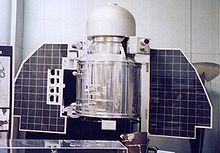
1960s
Between 1960 and 1969, the Soviet Union, launched nine probes intended to reach Mars. They all failed: three at launch; three failed to reach near-Earth orbit; one during the burn to put the spacecraft into trans-Mars trajectory; and two during the interplanetary orbit.
The Mars 1M programs (sometimes dubbed Marsnik in Western media) was the first Soviet unmanned spacecraft interplanetary exploration program, which consisted of two flyby probes launched towards Mars in October 1960, Mars 1960A and Mars 1960B (also known as Korabl 4 and Korabl 5 respectively). After launch, the third stage pumps on both launchers were unable to develop enough pressure to commence ignition, so Earth parking orbit was not achieved. The spacecraft reached an altitude of 120 km before reentry.
Mars 1962A was a Mars fly-by mission, launched on October 24, 1962 and Mars 1962B a lander mission, launched in late December of the same year (1962). Both failed from either breaking up as they were going into Earth orbit or having the upper stage explode in orbit during the burn to put the spacecraft into trans-Mars trajectory.
Mars 1 (1962 Beta Nu 1), an automatic interplanetary spacecraft launched to Mars on November 1, 1962, was the first probe of the Soviet Mars probe program to achieve interplanetary orbit. Mars 1 was intended to fly by the planet at a distance of about 11,000 km and take images of the surface as well as send back data on cosmic radiation, micrometeoroid impacts and Mars' magnetic field, radiation environment, atmospheric structure, and possible organic compounds.[19][20] Sixty-one radio transmissions were held, initially at two-day intervals and later at 5 day intervals, from which a large amount of interplanetary data was collected. On 21 March 1963, when the spacecraft was at a distance of 106,760,000 km from Earth, on its way to Mars, communications ceased due to failure of its antenna orientation system.[19][20]
In 1964, both Soviet probe launches, of Zond 1964A on June 4, and Zond 2 on November 30, (part of the Zond program), resulted in failures. Zond 1964A had a failure at launch, while communication was lost with Zond 2 en route to Mars after a mid-course maneuver, in early May 1965.
In 1969, and as part of the Mars probe program, the Soviet Union prepared two identical 5-ton orbiters called M-69, dubbed by NASA as Mars 1969A and Mars 1969B. Both probes were lost in launch-related complications with the newly developed Proton rocket.[21]
1970s
The USSR intended to have the first artificial satellite of Mars beating the planned American Mariner 8 and Mariner 9 Martian orbiters. In May 1971, one day after Mariner 8 malfunctioned at launch and failed to reach orbit, Cosmos 419 (Mars 1971C), a heavy probe of the Soviet Mars program M-71, also failed to launch. This spacecraft was designed as an orbiter only, while the next two probes of project M-71, Mars 2 and Mars 3, were multipurpose combinations of an orbiter and a lander. They were successfully launched in mid-May 1971 and reached Mars about seven months later. On November 27, 1971 the lander of Mars 2 crash-landed due to an on-board computer malfunction and became the first man-made object to reach the surface of Mars. In December 2, 1971 the Mars 3 lander became the first spacecraft to achieve a soft landing, but its transmission was interrupted after 14.5 seconds.
The Mars 2 and 3 orbiters sent back a relatively large volume of data covering the period from December 1971 to March 1972, although transmissions continued through to August. By 22 August 1972, after sending back data and a total of 60 pictures, Mars 2 and 3 concluded their missions. The images and data enabled creation of surface relief maps, and gave information on the Martian gravity and magnetic fields.[22]
In 1973, the Soviet Union sent four more probes to Mars: the Mars 4 and Mars 5 orbiters and the Mars 6 and Mars 7 fly-by/lander combinations. All missions except Mars 7 sent back data, with Mars 5 being most successful. Mars 5 transmitted 60 images before a loss of pressurization in the transmitter housing ended the mission. Mars 6 lander transmitted data during descent, but failed upon impact. Mars 4 flew by the planet at a range of 2200 km returning one swath of pictures and radio occultation data, which constituted the first detection of the nightside ionosphere on Mars.[23] Mars 7 probe separated prematurely from the carrying vehicle due to a problem in the operation of one of the onboard systems (attitude control or retro-rockets) and missed the planet by 1300 km.
Mariner program

In 1964, NASA's Jet Propulsion Laboratory made two attempts at reaching Mars. Mariner 3 and Mariner 4 were identical spacecraft designed to carry out the first flybys of Mars. Mariner 3 was launched on November 5, 1964, but the shroud encasing the spacecraft atop its rocket failed to open properly, dooming the mission. Three weeks later, on November 28, 1964, Mariner 4 was launched successfully on a 7½-month voyage to the red planet.
Mariner 4 flew past Mars on July 14, 1965, providing the first close-up photographs of another planet. The pictures, gradually played back to Earth from a small tape recorder on the probe, showed impact craters. It provided radically more accurate data about the planet; a surface atmospheric pressure of about 1% of Earth's and daytime temperatures of −100 °C (−148 °F) were estimated. No magnetic field[24][25] or Martian radiation belts[26] were detected. The new data meant redesigns for then planned Martian landers, and showed life would have a more difficult time surviving there than previously anticipated.[27][28][29][30]

NASA continued the Mariner program with another pair of Mars flyby probes, Mariner 6 and 7. They were sent at the next launch window, and reached the planet in 1969. During the following launch window the Mariner program again suffered the loss of one of a pair of probes. Mariner 9 successfully entered orbit about Mars, the first spacecraft ever to do so, after the launch time failure of its sister ship, Mariner 8. When Mariner 9 reached Mars in 1971, it and two Soviet orbiters (Mars 2 and Mars 3, see Mars probe program below) found that a planet-wide dust storm was in progress. The mission controllers used the time spent waiting for the storm to clear to have the probe rendezvous with, and photograph, Phobos. When the storm cleared sufficiently for Mars' surface to be photographed by Mariner 9, the pictures returned represented a substantial advance over previous missions. These pictures were the first to offer more detailed evidence that liquid water might at one time have flowed on the planetary surface. They also finally discerned the true nature of many Martian albedo features. For example, Nix Olympica was one of only a few features that could be seen during the planetary duststorm, revealing it to be the highest mountain (volcano, to be exact) on any planet in the entire Solar System, and leading to its reclassification as Olympus Mons.
Viking program
The Viking program launched Viking 1 and 2 spacecraft to Mars in 1975; The program consisted of two orbiters and two landers – these were the first two spacecraft to successfully land and operate on Mars.
|
Martian sunset over Chryse Planitia at Viking 1 site (August 20, 1976). |
The primary scientific objectives of the lander mission were to search for biosignatures and observe meteorologic, seismic and magnetic properties of Mars. The results of the biological experiments on board the Viking landers remain inconclusive, with a reanalysis of the Viking data published in 2012 suggesting signs of microbial life on Mars.[31][32]
|
Flood erosion at Dromore crater. Tear-drop shaped islands at Oxia Palus. Streamlined islands in Lunae Palus. |
The Viking orbiters revealed that large floods of water carved deep valleys, eroded grooves into bedrock, and traveled thousands of kilometers. Areas of branched streams, in the southern hemisphere, suggest that rain once fell.[33][34][35]
Mars Pathfinder
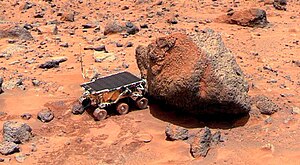
Mars Pathfinder was a U.S. spacecraft that landed a base station with a roving probe on Mars on July 4, 1997. It consisted of a lander and a small 10.6 kilograms (23 lb) wheeled robotic rover named Sojourner, which was the first rover to operate on the surface of Mars.[36][37] In addition to scientific objectives, the Mars Pathfinder mission was also a "proof-of-concept" for various technologies, such as an airbag landing system and automated obstacle avoidance, both later exploited by the Mars Exploration Rovers.
Mars Global Surveyor

After the 1992 failure of NASA's Mars Observer orbiter, NASA retooled and launched Mars Global Surveyor (MGS). This mission was the first successful United States mission, and the first fully successful mission overall, to the red planet in two decades when it launched November 7, 1996, and entered orbit on September 12, 1997. After a year and a half trimming its orbit from a looping ellipse to a circular track around the planet, the spacecraft began its primary mapping mission in March 1999. It observed the planet from a low-altitude, nearly polar orbit over the course of one complete Martian year, the equivalent of nearly two Earth years. Mars Global Surveyor completed its primary mission on January 31, 2001, and completed several extended mission phases.
The mission studied the entire Martian surface, atmosphere, and interior, and returned more data about the red planet than all previous Mars missions combined. The data has been archived and remains available publicly.[38]

Among key scientific findings, Global Surveyor took pictures of gullies and debris flow features that suggest there may be current sources of liquid water, similar to an aquifer, at or near the surface of the planet. Similar channels on Earth are formed by flowing water, but on Mars the temperature is normally too cold and the atmosphere too thin to sustain liquid water. Nevertheless, many scientists hypothesize that liquid groundwater can sometimes surface on Mars, erode gullies and channels, and pool at the bottom before freezing and evaporating.
Magnetometer readings showed that the planet's magnetic field is not globally generated in the planet's core, but is localized in particular areas of the crust. New temperature data and closeup images of the Martian moon Phobos showed that its surface is composed of powdery material at least 1 metre (3 feet) thick, caused by millions of years of meteoroid impacts. Data from the spacecraft's laser altimeter gave scientists their first 3-D views of Mars' north polar ice cap.
On November 5, 2006 MGS lost contact with Earth.[39] NASA ended efforts to restore communication on January 28, 2007.[40]
Mars Odyssey and Mars Express
In 2001 NASA's Mars Odyssey orbiter arrived at Mars. Its mission is to use spectrometers and imagers to hunt for evidence of past or present water and volcanic activity on Mars. In 2002, it was announced that the probe's gamma ray spectrometer and neutron spectrometer had detected large amounts of hydrogen, indicating that there are vast deposits of water ice in the upper three meters of Mars' soil within 60° latitude of the south pole.[citation needed]
On June 2, 2003, the European Space Agency's Mars Express set off from Baikonur Cosmodrome to Mars. The Mars Express craft consists of the Mars Express Orbiter and the lander Beagle 2. Although the landing probe was not designed to move, it carried a digging device and the smallest mass spectrometer created to date, as well as a range of other devices, on a robotic arm in order to accurately analyze soil beneath the dusty surface.
The orbiter entered Mars orbit on December 25, 2003, and Beagle 2 entered Mars' atmosphere the same day. However, attempts to contact the lander failed. Communications attempts continued throughout January, but Beagle 2 was declared lost in mid-February, and a joint inquiry was launched by the UK and ESA. The Mars Express Orbiter confirmed the presence of water ice and carbon dioxide ice at the planet's south pole, while NASA had previously confirmed their presence at the north pole of Mars.
MER and Phoenix

NASA's Mars Exploration Rover Mission (MER) is an ongoing robotic space mission involving two rovers, Spirit (1) and Opportunity, (2) exploring the planet Mars. It began in 2003 with the sending of the two rovers—MER-A Spirit and MER-B Opportunity—to explore the Martian surface and geology.
The mission's scientific objective was to search for and characterize a wide range of rocks and soils that hold clues to past water activity on Mars. The mission is part of NASA's Mars Exploration Program, which includes three previous successful landers: the two Viking program landers in 1976 and Mars Pathfinder probe in 1997
Mars Reconnaissance Orbiter
Mars Reconnaissance Orbiter is a multipurpose spacecraft designed to conduct reconnaissance and exploration of Mars from orbit. The $720 million USD spacecraft was built by Lockheed Martin under the supervision of the Jet Propulsion Laboratory, launched August 12, 2005, and attained Martian orbit on March 10, 2006.
The MRO contains a host of scientific instruments such as the HiRISE camera, CTX camera, CRISM, and SHARAD. The HiRISE camera is used to analyze Martian landforms, whereas CRISM and SHARAD can detect water, ice, and minerals on and below the surface. Additionally, MRO is paving the way for upcoming generations of spacecraft through daily monitoring of Martian weather and surface conditions, searching for future landing sites, and testing a new telecommunications system that enable it to send and receive information at an unprecedented bitrate, compared to previous Mars spacecraft. Data transfer to and from the spacecraft occurs faster than all previous interplanetary missions combined and allows it to serve as an important relay satellite for other missions.
Rosetta and Dawn swingbys
The ESA Rosetta space probe mission to the comet 67P/Churyumov-Gerasimenko flew within 250 km of Mars on February 25, 2007 in a gravitational slingshot designed to slow and redirect the spacecraft.[41] The NASA Dawn spacecraft also used the gravity of Mars to change direction and velocity, and did a little science in conjunction with the many probes already there.[citation needed] Dawn passed the red planet in February 2009.
Fobos-Grunt
In November 8, 2011, Russia's Roscosmos launched an ambitious mission called Fobos-Grunt. It was a lander aimed to retrieve a sample back to Earth from Mars' moon Phobos, and place the Chinese Yinghuo-1 probe in Mars' orbit. The Fobos-Grunt mission suffered a complete control and communications failure shortly after launch and was left stranded in low Earth orbit, later falling back to Earth.[42] The Yinghuo-1 satellite and Fobos-Grunt underwent destructive re-entry on January 15, 2012, finally disintegrating over the Pacific Ocean.[43][44][45]
Curiosity rover
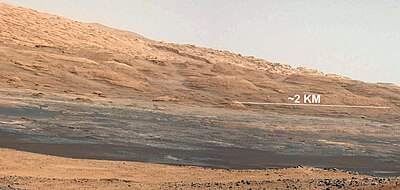
The NASA Mars Science Laboratory mission with its rover named Curiosity, was launched on November 26, 2011.[46][47] The rover carries instruments designed to look for past or present conditions relevant to the past or present habitability of Mars. The Curiosity rover landed on Mars on Aeolis Palus in Gale Crater, between Peace Vallis and Aeolis Mons (informally known as Mount Sharp),[48][49][50][51] on August 6, 2012 at 05:14:39 UTC.[52] The coordinates of the landing site (named "Bradbury Landing") are: (4°35′22″S 137°26′30″E / 4.5895°S 137.4417°E)[53][54]
MAVEN
NASA's MAVEN is an orbiter mission to study the atmosphere of Mars.[55] It will also serve as a communications relay satellite for robotic landers and rovers on the surface of Mars. MAVEN was launched 18 November 2013 and reached Mars on 22 September 2014.
Mars Orbiter Mission
The Mars Orbiter Mission, also called Mangalyaan, was launched on 5 November 2013 by the Indian Space Research Organisation (ISRO).[56] It was successfully inserted into Martian orbit on 24 September 2014. The mission is a technology demonstrator, and as secondary objective, it will also study the Martian atmosphere. This is India's first mission to Mars, and with it, ISRO became the fourth space agency to successfully reach Mars after the Soviet Union, NASA (USA) and ESA (Europe). It also made India the first country to reach Mars orbit on its first attempt and also the first Asian country to successfully send an orbiter to Mars.[14]
Future missions
- In August 2012, NASA selected InSight, a $425 million lander mission for 2016, with a drill and seismometer to determine the interior structure of Mars.[57][58][59]
- As part of the ExoMars program, ESA and the Russian Federal Space Agency plan to send the Trace Gas Orbiter and the Schiaparelli lander to Mars in 2016, and the ExoMars rover in 2018 to search for past or present microscopic life on Mars.[60]
- The Finnish-Russian MetNet concept would, if implemented in 2015, use multiple small meteorological stations on Mars to establish a widespread observation network to investigate the planet's atmospheric structure, physics and meteorology.[61] The MetNet precursor or demonstrator was considered for a piggyback launch on Phobos-Grunt,[62] and on the two planned 2016 and 2018 ExoMars spacecraft.[61]
- The Mars-Grunt is a Russian mission concept to bring a sample of Martian soil to Earth.[63]
- The ISRO plans to send a follow up mission to its Mars Orbiter Mission in the 2018-2020 timeframe; it is called Mangalyaan 2.[64][65][66] This mission will consist of a lander and a rover.[67][68]
- A ESA-NASA team produced a three-launch architecture concept for a Mars sample return, which uses a rover to cache small samples, a Mars ascent stage to send it into orbit, and an orbiter to rendezvous with it above Mars and take it to Earth.[69] Solar-electric propulsion could allow a one launch sample return instead of three.[70]
- The Mars Scout Program's SCIM would involve a probe grazing the upper atmosphere of Mars to scoop up dust and air for Earth return.[71]
- The Mars 2020 rover mission by NASA would be launched in 2020, and it would be based on the Mars Science Laboratory design. The scientific payload will be focused on astrobiology.[72]
- The United Arab Emirates announced that the first mission of its space agency will be to send an unmanned mission to Mars by 2021.[73]
- On 10 Nov 2014, China unveiled a prototype model of a rover based on its lunar rover Yutu at an annual air show at Zhuai. The CASC also said that a mission including an orbiter, lander and the rover will be sent before 2020.[74]
Other future mission concepts include new polar probes, Martian aircraft and a network of small meteorological stations.[69] Longterm areas of study may include Martian lava tubes, resource utilization, and electronic charge carriers in rocks.[75][76] Micromissions are another possibility, such as piggybacking a small spacecraft on an Ariane 5 rocket and using a lunar gravity assist to get to Mars.[77]
Past missions
| Decade |
|
|---|---|
| 1960s | |
| 1970s | |
| 1980s | |
| 1990s | |
| 2000s | |
| 2010s |
Starting in 1960 the Soviets launched a series of probes to Mars.[78] The first successful fly-by of Mars was on July 14–15, 1965, by NASA's Mariner 4.[79] On November 14, 1971 Mariner 9 became the first space probe to orbit another planet when it entered into orbit around Mars.[80] The amount of data returned by probes increased dramatically as technology improved.[78]
The first to contact the surface were two Soviet probes: Mars 2 lander on November 27 and Mars 3 lander on December 2, 1971—Mars 2 failed during descent and Mars 3 about twenty seconds after landing.[81] Mars 6 failed during descent but did return some corrupted atmospheric data in 1974. [82] The 1975 NASA launches of the Viking program consisted of two orbiters, each with a lander that successfully touched down in 1976. Viking 1 remained operational for six years, Viking 2 for three. The Viking landers relayed the first color panoramas of Mars[83] and the Viking orbiters mapped the surface so well that the images remain in use.
The Soviet probes Phobos 1 and 2 were sent to Mars in 1988 to study Mars and its two moons, with a focus on Phobos. Phobos 1 lost contact on the way to Mars. Phobos 2, while successfully photographing Mars and Phobos, failed before it was set to release two landers to the surface of Phobos.[84]
Roughly two-thirds of all spacecraft destined for Mars have failed without completing their missions, and it has a reputation as difficult space exploration target.[85] Missions that ended prematurely after Phobos 1 & 2 (1988) include Mars Observer (Launched in 1992), Mars 96 (1996), Mars Climate Orbiter (1999), Mars Polar Lander with Deep Space 2 (1999), Nozomi (2003), Beagle 2 (2003), and Fobos-Grunt with Yinghuo-1 (2011). (See Probing difficulties section)
Following the 1993 failure of the Mars Observer orbiter, the NASA Mars Global Surveyor achieved Mars orbit in 1997. This mission was a complete success, having finished its primary mapping mission in early 2001. Contact was lost with the probe in November 2006 during its third extended program, spending exactly 10 operational years in space. The NASA Mars Pathfinder, carrying a robotic exploration vehicle Sojourner, landed in the Ares Vallis on Mars in the summer of 1997, returning many images.[86]
Phoenix landed on the north polar region of Mars on May 25, 2008.[87] Its robotic arm dug into the Martian soil and the presence of water ice was confirmed on June 20, 2008.[88][89] The mission concluded on November 10, 2008 after contact was lost.[90] In 2008, the price of transporting material from the surface of Earth to the surface of Mars was approximately US$309,000 per kilogram.[91]
Rosetta came within 250 km of Mars during its 2007 flyby. [92] Dawn flew by Mars in February 2009 for a gravity assist on its way to investigate Vesta and Ceres. [93]
Human mission proposals
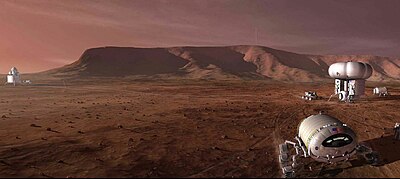
Many people have long advocated a human mission to Mars as the next logical step for a human space program after lunar exploration. Aside from the prestige such a mission would bring, advocates argue that humans would easily be able to outperform robotic explorers, justifying the expense. Aerospace engineer Bob Zubrin is one of the proponents of such missions. Some critics contend unmanned robots can perform better than humans at a fraction of the expense. If life exists on Mars, a human mission could contaminate it by introducing earthly microbes, so robotic exploration would be preferable.[94] A list of hypothetical or proposed human Mars missions is located at human mission to Mars. See also, colonization of Mars.
ESA
The ESA has plans to land humans on Mars between 2030 and 2035.[95] This will be preceded by successively larger probes, starting with the launch of the ExoMars probe[95] and a planned joint NASA–ESA Mars sample return mission.[96]
NASA
Human exploration by the United States was identified as a long-term goal in the Vision for Space Exploration announced in 2004 by then US President George W. Bush.[97] The planned Orion spacecraft would be used to send a human expedition to Earth's moon by 2020 as a stepping stone to a Mars expedition. On September 28, 2007, NASA administrator Michael D. Griffin stated that NASA aims to put a person on Mars by 2037.[98]
On December 2, 2014, NASA's Advanced Human Exploration Systems and Operations Mission Director Jason Crusan and Deputy Associate Administrator for Programs James Reuthner announced tentative support for the Boeing "Affordable Mars Mission Design" including radiation shielding, centrifugal artificial gravity, in-transit consumable resupply, and a lander which can return.[99][100] Reuthner suggested that if adequate funding was forthcoming, the proposed mission would be expected in the early 2030s.[101]
Zubrin
Mars Direct, a low-cost human mission proposed by Robert Zubrin, founder of the Mars Society, would use heavy-lift Saturn V class rockets, such as the Ares V, to skip orbital construction, LEO rendezvous, and lunar fuel depots. A modified proposal, called "Mars to Stay", involves not returning the first immigrant explorers immediately, if ever (see Colonization of Mars).[97][98][102][102] [103]
Probing difficulties
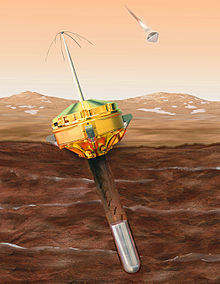
The challenge, complexity and length of Mars missions make it likely that failures can occur.[104] The high failure rate of missions launched from Earth attempting to explore Mars was informally called the "Mars Curse" or "Martian Curse".[105] The phrase "Galactic Ghoul"[106] or "Great Galactic Ghoul", referring to a fictitious space monster that subsists on a diet of Mars probes, was coined in 1997 by Time Magazine journalist Donald Neff, and is sometimes facetiously used to "explain" the recurring difficulties.[107][108][109][110]
Two Soviet probes were sent to Mars in 1988 as part of the Phobos program. Phobos 1 operated normally until an expected communications session on 2 September 1988 failed to occur. The problem was traced to a software error, which deactivated attitude thrusters causing the spacecrafts' solar arrays to no longer point at the Sun, depleting Phobos 1 batteries. Phobos 2 operated normally throughout its cruise and Mars orbital insertion phases on January 29, 1989, gathering data on the Sun, interplanetary medium, Mars, and Phobos. Shortly before the final phase of the mission, during which the spacecraft was to approach within 50 m of Phobos' surface and release two landers, one a mobile 'hopper', the other a stationary platform, contact with Phobos 2 was lost. The mission ended when the spacecraft signal failed to be successfully reacquired on March 27, 1989. The cause of the failure was determined to be a malfunction of the on-board computer.[citation needed]
Just a few years later in 1992 Mars Observer, launched by NASA, failed as it approached Mars. Mars 96, an orbiter launched on November 16, 1996 by Russia failed, when the planned second burn of the Block D-2 fourth stage did not occur.[111]
Following the success of Global Surveyor and Pathfinder, another spate of failures occurred in 1998 and 1999, with the Japanese Nozomi orbiter and NASA's Mars Climate Orbiter, Mars Polar Lander, and Deep Space 2 penetrators all suffering various fatal errors. Mars Climate Orbiter was noted for mixing up U.S. customary units with metric units, causing the orbiter to burn up while entering Mars' atmosphere.
Timeline of Mars exploration
Source:[112]
Totals
| Mission type | Success rate | Total attempts | Success | Partial success | Launch failure | Failed en route | Failed to orbit/land |
|---|---|---|---|---|---|---|---|
| Flyby | 45% | 11 | 5 | 0 | 4 | 2 | 0 |
| Orbiter | 50% | 23 | 10 | 2 | 5 | 3 | 3 |
| Lander | 53% | 15 | 8 | 0 | 0 | 3 | 4 |
| Rover | 66% | 6 | 4 | 0 | 0 | 0 | 2 |
| Sample return | 0% | 1 | 0 | 0 | 0 | 1 (Phobos) | 0 |
| Total | 51% | 55 | 26 | 2 | 9 | 9 | 9 |
| Mars missions by year | |
|---|---|
 |
|
| 1969/1971 and 1986/1988 are historical minimum energy launch windows to Mars | |
| note: for the purpose of this graph an orbiter carrying a lander is considered two missions | |
Timeline
| Mission (1960–1969) | Launch | Arrival at Mars | Termination | Elements | Outcome |
|---|---|---|---|---|---|
| 10 October 1960 | 10 October 1960 | Flyby | Launch failure | ||
| 14 October 1960 | 14 October 1960 | Flyby | Launch failure | ||
| 24 October 1962 | 24 October 1962 | Flyby | Broke up shortly after launch | ||
| 1 November 1962 | 21 March 1963 | Flyby | Some data collected, but lost contact before reaching Mars, flyby at approx. 193,000 km | ||
| 4 November 1962 | 19 January 1963 | Lander | Failed to leave Earth's orbit | ||
| 5 November 1964 | 5 November 1964 | Flyby | Failure during launch ruined trajectory | ||
| 28 November 1964 | 14 July 1965 | 21 December 1967 | Flyby | Success (21 images returned)[78] | |
| 30 November 1964 | May 1965 | Flyby | Communication lost three months before reaching Mars | ||
| 25 February 1969 | 31 July 1969 | August 1969 | Flyby | Success | |
| 27 March 1969 | 5 August 1969 | August 1969 | Flyby | Success | |
| 27 March 1969 | 27 March 1969 | Orbiter | Launch failure | ||
| 2 April 1969 | 2 April 1969 | Orbiter | Launch failure | ||
| Mission (1970–1989) | Launch | Arrival at Mars | Termination | Elements | Outcome |
| 8 May 1971 | 8 May 1971 | Orbiter | Launch failure | ||
| 10 May 1971 | 12 May 1971 | Orbiter | Launch failure | ||
| 30 May 1971 | 13 November 1971 | 27 October 1972 | Orbiter | Success (first successful orbit) | |
| 19 May 1971 | 27 November 1971 | 22 August 1972 | Orbiter | Success | |
| 27 November 1971 | Lander, rover[36] | Crashed on surface of Mars | |||
| 28 May 1971 | 2 December 1971 | 22 August 1972 | Orbiter | Success | |
| 2 December 1971 | Lander, rover[36] | Partial success. First successful landing; landed softly but ceased transmission within 15 seconds | |||
| 21 July 1973 | 10 February 1974 | 10 February 1974 | Orbiter | Could not enter orbit, made a close flyby | |
| 25 July 1973 | 2 February 1974 | 21 February 1974 | Orbiter | Partial success. Entered orbit and returned data, but failed within 9 days[113] | |
| 5 August 1973 | 12 March 1974 | 12 March 1974 | Lander | Partial success. Data returned during descent but not after landing on Mars | |
| 9 August 1973 | 9 March 1974 | 9 March 1974 | Lander | Landing probe separated prematurely; entered heliocentric orbit | |
| 20 August 1975 | 20 July 1976 | 17 August 1980 | Orbiter | Success | |
| 13 November 1982 | Lander | Success | |||
| 9 September 1975 | 3 September 1976 | 25 July 1978 | Orbiter | Success | |
| 11 April 1980 | Lander | Success | |||
| 7 July 1988 | 2 September 1988 | Orbiter | Contact lost while en route to Mars[114] | ||
| Lander | Not deployed | ||||
| 12 July 1988 | 29 January 1989 | 27 March 1989 | Orbiter | Partial success: entered orbit and returned some data. Contact lost just before deployment of landers | |
| Landers | Not deployed | ||||
| Mission (1990–1999) | Launch | Arrival at Mars | Termination | Elements | Outcome |
| 25 September 1992 | 24 August 1993 | 21 August 1993 | Orbiter | Lost contact just before arrival | |
| 7 November 1996 | 11 September 1997 | 5 November 2006 | Orbiter | Success | |
| 16 November 1996 | 17 November 1996 | Orbiter, lander, penetrator | Launch failure | ||
| 4 December 1996 | 4 July 1997 | 27 September 1997 | Lander, rover | Success | |
| 3 July 1998 | 9 December 2003 | Orbiter | Complications while en route; Never entered orbit[115] | ||
| 11 December 1998 | 23 September 1999 | 23 September 1999 | Orbiter | Crashed on surface due to metric-imperial mix-up | |
| 3 January 1999 | 3 December 1999 | 3 December 1999 | Lander | Crash-landed on surface due to improper hardware testing | |
| Hard landers | |||||
| Mission (2000–2009) | Launch | Arrival at Mars | Termination | Elements | Outcome |
| 7 April 2001 | 24 October 2001 | Currently operational | Orbiter | Success | |
| 2 June 2003 | 25 December 2003 | Currently operational | Orbiter | Success | |
| 6 February 2004 | Lander | Partial success. Landed safely but failed to fully deploy, blocking access to its radio antennas.[116] | |||
| 10 June 2003 | 4 January 2004 | 22 March 2011 | Rover | Success | |
| 7 July 2003 | 25 January 2004 | Currently operational | Rover | Success | |
| 2 March 2004 | 25 February 2007 | Currently operational | Flyby/Gravity assist en route to comet 67P/Churyumov-Gerasimenko | Successful Mars flyby. | |
| 12 August 2005 | 10 March 2006 | Currently operational | Orbiter | Success | |
| 4 August 2007 | 25 May 2008 | 10 November 2008 | Lander | Success | |
| 27 September 2007 | 17 February 2009 | Currently operational | Gravity assist to Vesta | Success | |
| Mission (2010–2019) | Launch | Arrival at Mars | Termination | Elements | Outcome |
| 8 November 2011 | 8 November 2011 | Phobos lander, sample return | Failed to leave Earth orbit.[117] Fell back to Earth.[118] | ||
| China National Space Administration Yinghuo-1 | 8 November 2011 | Orbiter | |||
| 26 November 2011 | 6 August 2012 | Currently operational | Rover | Success | |
| 5 November 2013 | 24 September 2014 | Currently operational | Orbiter | In orbit and operational[119] | |
| 18 November 2013 | 22 September 2014 | Currently operational | Orbiter | In orbit and operational [56] |
Future missions
| Name | Estimated launch |
Elements | Notes |
|---|---|---|---|
| March 2016 | Lander, drill | Study interior structure of Mars. | |
| 2016 | Orbiter, lander | Trace Gas Orbiter also will deliver the Schiaparelli EDM lander. | |
| 2018 | Lander, rover | Russian lander to deploy ESA ExoMars rover. | |
| 2020 | Rover | Astrobiology objectives; rover is based on the Curiosity rover.[120] |
Under study
| Name | Estimated launch |
Elements | Notes |
|---|---|---|---|
| 2015 or later[61] | Single impact lander test | Precursor for multi-lander network.[121] | |
| after precursor[61] | Multi-lander network | Simultaneous meteorological measurements at multiple locations.[61][121] | |
| 2018 | Orbiter, lander | Mars orbiter and lander launched by a GSLV launcher.[64][122] | |
| January 2016 | Lander | The first demonstration is proposed for launch in 2016.[123][124] | |
| 2016 | Orbiter | Communications satellite. | |
| 2016 | Lander | Would have the ability to fly or "hop" at least twice from its landed location to reposition itself close to a CO2 geyser site. | |
| 5 January 2018 | Manned flyby | Private mission to send two humans around Mars on a free return trajectory, without landing.[125] | |
| 2018 | Rover | Rover to select location for colony.[126] | |
| 2018 or 2020 | Stationary lander | Based on the 2008 Phoenix lander, would perform astrobiology tests on sub-surface ice.[127] | |
| 2020 | Orbiter | Would study Phobos and Deimos [128][129] | |
| 2020 | Rover, sample return | Landing by 2020, soil sample returned by 2030.[130] | |
| 2021 | 6 landers, rover | Two living units, two life support units and two supply units, with a second rover.[126] | |
| 2021 | Flyby | Would become the first Arab probe to Mars.[73] | |
| 2022 | Lander | Falcon Heavy rocket with a Dragon capsule; would look for biosignatures.[131][132] | |
| 2022 | 3 landers | Meteorological network concept.[133] | |
| 2022 | Lander and ascent stage | Mars moon sample return mission.[133] | |
| 2022 | Orbiter[135] | Communications relay | |
| 2022 | Manned mission | Colony.[126] | |
| 2025 | Manned mission | Four more colonists.[126] | |
| 2020s | Orbiter, lander | Would study geology and atmosphere.[136] | |
| 2020s | Orbiter, lander, ascent stage | Single launch Mars sample return. | |
| 2020s | 6 landers | The Biological Oxidant and Life Detection would perform astrobiology tests on sub-surface soil.[137][138] |
Undeveloped concepts
- Mars 4NM and Mars 5NM – projects intended by the Soviet Union for heavy Marsokhod (in 1973 according to initial plan of 1970) and Mars sample return (planned for 1975) missions by launching on N1 rocket that has never flown successfully.[139]
- Voyager – USA, 1970s – Two orbiters and two landers, launched by a single Saturn V rocket.
- Mars Aerostat – Russian/French balloon mission,[140] originally planned for the 1992 launch window, postponed to 1994 and then to 1996 before being cancelled.[141]
- Mars Environmental Survey – set of 16 landers planned for 1999–2009
- Mars-98 – Russian mission including an orbiter, lander, and rover, planned for 1998 launch opportunity
- Mars Surveyor 2001 Lander – October 2001 – Mars lander (refurbished, became Phoenix lander)
- Beagle 3 – 2009 British lander mission meant to search for life, past or present.
- NetLander- 2007 or 2009 – Mars netlanders
- Mars Telecommunications Orbiter – September 2009 – Mars orbiter for telecommunications
- Mars Astrobiology Explorer-Cacher – 2018 rover
- Kitty Hawk – Mars airplane micromission, proposed for December 17, 2003, the centennial of the Wright brothers' first flight.[142] Its funding was eventually given to the 2003 Mars Network project.[143]
- Tumbleweed rover.[144]
See also
- Mars
- Colonization of Mars
- Inspiration Mars Foundation
- Life on Mars
- List of artificial objects on Mars
- List of rocks on Mars
- Manned mission to Mars
- Mariner (crater)
- Mars Analog Habitats
- Mars Scout Program
- Mars to Stay
- The Mars Society
- General
References
- ^ a b Grotzinger, John P. (24 January 2014). "Introduction to Special Issue - Habitability, Taphonomy, and the Search for Organic Carbon on Mars". Science. 343 (6169): 386–387. Bibcode:2014Sci...343..386G. doi:10.1126/science.1249944. Retrieved 24 January 2014.
- ^ "Special Issue - Table of Contents - Exploring Martian Habitability". Science. 343 (6169): 345–452. 24 January 2014. Retrieved 24 January 2014.
{{cite journal}}: Unknown parameter|authors=ignored (help) - ^ "Special Collection - Curiosity - Exploring Martian Habitability". Science. 24 January 2014. Retrieved 24 January 2014.
{{cite journal}}: Unknown parameter|authors=ignored (help) - ^ "A Habitable Fluvio-Lacustrine Environment at Yellowknife Bay, Gale Crater, Mars". Science. 343 (6169). 24 January 2014. doi:10.1126/science.1242777. Retrieved 24 January 2014.
{{cite journal}}: Unknown parameter|authors=ignored (help) - ^ "NASA's Mars Odyssey Shifting Orbit for Extended Mission". NASA. October 9, 2008. Retrieved 2008-11-15.
- ^ Britt, Robert (March 14, 2003). "Odyssey Spacecraft Generates New Mars Mysteries". Space.com. Archived from the original on 2006-03-15. Retrieved 2006-06-13.
- ^ Pearson, Michael (16 January 2015). "UK's Beagle 2 lander spotted on Mars". CNN. Retrieved 2015-01-17.
- ^ ESA Media Relations Division (February 11, 2004). "UK and ESA announce Beagle 2 inquiry". ESA News. Retrieved 2011-04-28.
- ^ Bertaux, Jean-Loup; et al. (June 9, 2005). "Discovery of an aurora on Mars". Nature. 435 (7043): 790–4. Bibcode:2005Natur.435..790B. doi:10.1038/nature03603. PMID 15944698.
{{cite journal}}: Explicit use of et al. in:|author2=(help) - ^ "Mars Exploration Rovers- Science". MER website. NASA. Retrieved 2006-06-13.
- ^ "Photo shows avalanche on Mars". CNN. Archived from the original on April 19, 2008. Retrieved 2008-03-04.
{{cite news}}: Unknown parameter|deadurl=ignored (|url-status=suggested) (help) - ^ "Mars Science Laboratory — Homepage". NASA.
- ^ "Chemistry and Cam (ChemCam)". NASA.
- ^ a b Majumder, Sanjoy (5 November 2013). "India launches spacecraft to Mars". BBC News. Retrieved 2014-01-26.
If the satellite orbits the Red Planet, India's space agency is the fourth in the world after those of the US, Russia and Europe to undertake a successful Mars mission
- ^ "Isro's Mars mission successful, India makes history". Retrieved 13 December 2014.
- ^ Sheehan, William (1996). "The Planet Mars: A History of Observation and Discovery". The University of Arizona Press, Tucson. Retrieved 2009-02-15.
- ^ D. McCleese, et al. - Robotic Mars Exploration Strategy
- ^ a b c David S. F. Portree, Humans to Mars: Fifty Years of Mission Planning, 1950–2000, NASA Monographs in Aerospace History Series, Number 21, February 2001. Available as NASA SP-2001-4521.
- ^ a b Robbins, Stuart (2008). ""Journey Through the Galaxy" Mars Program: Mars ~ 1960-1974". SJR Design. Retrieved 2014-01-26.
- ^ a b Mihos, Chris (11 January 2006). "Mars (1960-1974): Mars 1". Department of Astronomy, Case Western Reserve University. Retrieved 2014-01-26.
- ^ "NASA A Chronology of Mars Exploration". Retrieved 2007-03-28.
- ^ "NASA (NSSDC) Master Catalog Display Mars 3". Retrieved 2007-03-28.
- ^ "NASA (NSSDC) Master Catalog Display Mars 4". Retrieved 2007-03-28.
- ^ O'Gallagher, J.J.; Simpson, J.A. (September 10, 1965). "Search for Trapped Electrons and a Magnetic Moment at Mars by Mariner IV". Science, New Series. 149 (3689): 1233–1239. Bibcode:1965Sci...149.1233O. doi:10.1126/science.149.3689.1233. PMID 17747452.
- ^ Smith, Edward J. (September 10, 1965). "Magnetic Field Measurements Near Mars". Science, New Series. 149 (3689): 1241–1242. Bibcode:1965Sci...149.1241S. doi:10.1126/science.149.3689.1241. PMID 17747454.
{{cite journal}}: Unknown parameter|coauthors=ignored (|author=suggested) (help) - ^ Van Allen, J.A.; Frank, L.A.; Krimigis, S.M.; Hills, H.K. (September 10, 1965). "Absence of Martian Radiation Belts and Implications Thereof". Science, New Series. 149 (3689): 1228–1233. Bibcode:1965Sci...149.1228V. doi:10.1126/science.149.3689.1228. PMID 17747451.
- ^ Leighton, Robert B.; Murray, Bruce C.; Sharp, Robert P.; Allen, J. Denton; Sloan, Richard K. (August 6, 1965). "Mariner IV Photography of Mars: Initial Results". Science, New Series. 149 (3684): 627–630. Bibcode:1965Sci...149..627L. doi:10.1126/science.149.3684.627. PMID 17747569.
- ^ Kliore, Arvydas; Cain, Dan L.; Levy, Gerald S.; Eshleman, Von R.; Fjeldbo, Gunnar; Drake, Frank D. (September 10, 1965). "Occultation Experiment: Results of the First Direct Measurement of Mars's Atmosphere and Ionosphere". Science, New Series. 149 (3689): 1243–1248. Bibcode:1965Sci...149.1243K. doi:10.1126/science.149.3689.1243. PMID 17747455.
- ^ Salisbury, Frank B. (April 6, 1962). "Martian Biology". Science, New Series. 136 (3510): 17–26. Bibcode:1962Sci...136...17S. doi:10.1126/science.136.3510.17. PMID 17779780.
- ^ Kilston, Steven D.; Drummond, Robert R.; Sagan, Carl (1966). "A Search for Life on Earth at Kilometer Resolution". Icarus. 5 (1–6): 79–98. Bibcode:1966Icar....5...79K. doi:10.1016/0019-1035(66)90010-8.
- ^ Bianciardi, Giorgio; Miller, Joseph D.; Straat, Patricia Ann; Levin, Gilbert V. (March 2012). "Complexity Analysis of the Viking Labeled Release Experiments". IJASS. 13 (1): 14–26. Bibcode:2012IJASS..13...14B. doi:10.5139/IJASS.2012.13.1.14. Retrieved 15 April 2012.
- ^ Klotz, Irene (12 April 2012). "Mars Viking Robots 'Found Life'". DiscoveryNews. Retrieved 16 April 2012.
- ^ Matthews, Mildred S. (1 October 1992). Mars. University of Arizona Press. ISBN 978-0-8165-1257-7. Retrieved 14 August 2012.
- ^ Raeburn, P. (1998) "Uncovering the Secrets of the Red Planet Mars". National Geographic Society. Washington D.C. ISBN 0792273737.
- ^ Moore, Patrick; Hunt, Garry (1 January 1997). The Atlas of the Solar System. Chancellor Press. ISBN 978-0-7537-0014-3. Retrieved 14 August 2012.
{{cite book}}: CS1 maint: multiple names: authors list (link) - ^ a b c "The First Rover on Mars – The Soviets Did It in 1971". The Planetary Report. August 1990. Archived from the original on 2011-06-05. Retrieved 2012-04-05.
{{cite web}}:|first=missing|last=(help) - ^ December 4, 1996 – First successful Mars Rover – Sojourner – was launched. Todayinspacehistory.wordpress.com (2007-12-04). Retrieved on 2012-08-14.
- ^ "PDS Geosciences Node Data and Services: MGS". Retrieved 2006-08-27.
- ^ David, Leonard. "Mars Global Surveyor Remains Silent, Feared Lost". Retrieved 2007-04-01.
- ^ Mars Global Surveyor Operations Review Board. "Mars Global Surveyor (MGS) Spacecraft Loss of Contact" (PDF). Retrieved 2012-02-15.
- ^ "Europe set for billion-euro gamble with comet-chasing probe". PhysOrg.com. 2007-02-23. Archived from the original on 2007-02-25.
- ^ "Russia's failed Phobos-Grunt space probe heads to Earth", BBC News (2012-01-14).
- ^ "Phobos-Grunt: Failed Russian Mars Probe Falls to Earth". ABC News, January 15, 2012.
- ^ "Phobos-Grunt: Failed probe likely to return late Sunday". BBC News (2012-01-15).
- ^ Morris Jones (2011-11-17). "Yinghuo Was Worth It". Space Daily. Retrieved 19 November 2011.
- ^ "Mars Science Laboratory Launch". 26 November 2011. Retrieved 2011-11-26.
- ^ Associated Press (26 November 2011). "NASA Launches Super-Size Rover to Mars: 'Go, Go!'". New York Times. Retrieved 2011-11-26.
- ^ USGS (16 May 2012). "Three New Names Approved for Features on Mars". USGS. Retrieved 28 May 2012.
- ^ "'Mount Sharp' on Mars Compared to Three Big Mountains on Earth". NASA. 27 March 2012. Retrieved 31 March 2012.
- ^ Agle, D. C. (28 March 2012). "'Mount Sharp' On Mars Links Geology's Past and Future". NASA. Retrieved 31 March 2012.
- ^ "NASA's New Mars Rover Will Explore Towering 'Mount Sharp'". Space.com. 29 March 2012. Retrieved 30 March 2012.
- ^ "NASA – Curiosity Lands on Mars". Nasa.gov. 2012-04-17. Retrieved 2012-08-06.
- ^ MSNBC Staff (August 6, 2012). "Video from rover looks down on Mars during landing". MSNBC. Retrieved October 7, 2012.
- ^ Young, Monica (August 7, 2012). "Watch Curiosity Descend onto Mars". SkyandTelescope.com. Retrieved October 7, 2012.
- ^ "NASA Selects 'MAVEN' Mission to Study Mars Atmosphere". Nasa. Retrieved 2009-09-20.
- ^ a b NASA - MAVEN Launch Updates
- ^ NASA will send robot drill to Mars in 2016, Washington Post, By Brian Vastag, Monday, August 20
- ^ Concepts and Approaches for Mars Exploration – LPI – USRA (2012). Lpi.usra.edu. Retrieved on 2012-05-10.
- ^ "InSight: Mission". Mission Website. NASA's Jet Propulsion Laboratory. Retrieved 7 December 2011.
- ^ "ExoMars: ESA and Roscosmos set for Mars missions". European Space Agency (ESA). 14 March 2013. Retrieved 2013-03-14.
- ^ a b c d e Harri, A. M. (2012). "Future Plans for MetNet Lander Mars Missions" (PDF). Geophysical Research Abstracts. 14 (EGU2012-8224). Retrieved 18 February 2014.
{{cite journal}}: Unknown parameter|coauthors=ignored (|author=suggested) (help) - ^ "The MetNet Mars Precursor Mission". Finnish Meteorological Institute. Retrieved 2008-08-28.
- ^ Day, Dwayne A. (2011-11-28). "Red Planet blues". The Space Review. Retrieved 2012-01-16.
- ^ a b "India plans another Mars mission in 2017-20". The Times of India. Jul 18, 2014. Retrieved Jul 30, 2014.
- ^ "Second mission to Mars may be by 2020: ISRO chief K Radhakrishnan". The Economic Times. Press Trust of India. 12 November 2014. Retrieved 12 November 2014.
- ^ Dodhiya, K.A. (4 January 2014). "Chandrayaan-II in full progress: Isro ex-chief". Tha Asian Age. Mumbai, India. Retrieved 2015-02-14.
- ^ "India plans second Mars mission in 2018". CNN-IBN. Indo-Asian News Service. 30 October 2014. Retrieved 2014-10-30.
- ^ "ISRO's MANGALYAAN-2 Mission to launch in 2018". NIT Sparrows. 2014. Retrieved 2015-02-14.
- ^ a b Planetary Science Decadal Survey Mission & Technology Studies. Sites.nationalacademies.org. Retrieved on 2012-05-10.
- ^ Oh, David Y. et al. (2009) Single Launch Architecture for Potential Mars Sample Return Mission Using Electric Propulsion. JPL/Caltech.
- ^ Jones, S.M. et al. Mars Sample Return at 6 Kilometers per Second: Practical, Low Cost, Low Risk, and Ready. Ground Truth from Mars: Science Payoff from a Sample Return Mission, held April 21–23, 2008, in Albuquerque, New Mexico. LPI Contribution No. 1401, pp. 39–40.
- ^ NASA Announces Mars 2020 Rover Payload to Explore the Red Planet as Never Before. July 31, 2014.
- ^ a b Tharoor, Ishaan 2014/16/07. "U.A.E. plans Arab world’s first mission to Mars".
- ^ [1]. November 2014.
- ^ Decadal Survey Document Listing: White Papers (NASA)
- ^ Balloons – NASA. Mars.jpl.nasa.gov. Retrieved on 2012-05-10.
- ^ Oliver Morton – '''MarsAir''' (January 2000) – Air & Space magazine. Airspacemag.com. Retrieved on 2012-08-14.
- ^ a b c NASA PROGRAM & MISSIONS Historical Log. Mars.jpl.nasa.gov. Retrieved on 2012-08-14.
- ^ "Mariner 4". NSSDC Master Catalog. NASA. Retrieved 2009-02-11.
- ^ "Mariner 9: Overview". NASA.
- ^ Mars 2 Lander – NASA. Nssdc.gsfc.nasa.gov. Retrieved on 2012-05-10.
- ^ Mars 6 – NASA. Nssdc.gsfc.nasa.gov. Retrieved on 2012-05-10.
- ^ "Other Mars Missions". Journey through the galaxy. Retrieved 2006-06-13.
- ^ Sagdeev, R. Z.; Zakharov, A. V. (October 19, 1989). "Brief history of the Phobos mission". Nature. 341 (6243): 581–585. Bibcode:1989Natur.341..581S. doi:10.1038/341581a0.
{{cite journal}}: CS1 maint: multiple names: authors list (link) - ^ Dinerman, Taylor (September 27, 2004). "Is the Great Galactic Ghoul losing his appetite?". The space review. Retrieved 2007-03-27.
- ^ "Mars Global Surveyor". CNN- Destination Mars. Archived from the original on April 15, 2006. Retrieved 2006-06-13.
{{cite news}}: Unknown parameter|deadurl=ignored (|url-status=suggested) (help) - ^ "Mars Pulls Phoenix In". University of Arizona Phoenix mission Website. Retrieved 2008-05-25.
- ^ "Phoenix: The Search for Water". NASA website. Retrieved 2007-03-03.
- ^ "Frozen Water Confirmed on Mars". UANews.org. Retrieved 2008-08-24.
- ^ Amos, Jonathan (November 10, 2008). "NASA Mars Mission declared dead". BBC. Retrieved 2008-11-10.
- ^ Mitchell, Cary L.; Purdue University. "Living in Space". The Universe. Season 2008–09. Episode 307.
{{cite episode}}: Unknown parameter|episodelink=ignored (|episode-link=suggested) (help); Unknown parameter|serieslink=ignored (|series-link=suggested) (help) - ^ Space probe performs Mars fly-by. BBC News (2007-02-25). Retrieved on 2012-08-14.
- ^ Agle, D. C. (February 12, 2009). "NASA Spacecraft Falling For Mars". NASA/JPL. Retrieved 2009-12-27.
- ^ Lupisella, ML. "Human Mars Mission Contamination Issues." NASA.
- ^ a b "The ESA-NASA ExoMars programme 2016–2018—an overview". European Space Agency. December 12, 2009. Retrieved 2009-12-30.
- ^ "Mars Sample Return". European Space Agency. December 8, 2009. Retrieved 2009-12-30.
- ^ a b Britt, Robert. "When do we get to Mars?". Space.com FAQ: Bush's New Space Vision. Archived from the original on 2006-02-09. Retrieved 2006-06-13.
- ^ a b "NASA aims to put man on Mars by 2037". AFP.
- ^ http://www.hou.usra.edu/meetings/lpsc2014/eposter/2258
- ^ https://www.dropbox.com/s/0gagd1dbyptnvwg/Raftery_05-14-14.pdf
- ^ https://www.youtube.com/watch?v=zBoj-1m-qLU&ab_channel=NASA
- ^ a b "The Mars Homestead Project—Arrive, Survive, & Thrive!". Marshome.org. Retrieved 2009-09-20.
- ^ "Liftoff for Aurora: Europe's first steps to Mars, the Moon and beyond". October 11, 2002. Retrieved 2007-03-03.
- ^ The "Mars Curse": Why Have So Many Missions Failed?. Universetoday.com (2008-03-22). Retrieved on 2012-08-14.
- ^ Knight, Matthew. "Beating the curse of Mars". Science & Space. Retrieved 2007-03-27.
- ^ Bothwell, William (2008-10-23). "Looking to Mars". Orangeville Citizen. Retrieved 2008-10-29.
- ^ "The Depths of Space: The Story of the Pioneer Planetary Probes (2004)" from The National Academies Press. URL accessed April 7, 2006.
- ^ "Uncovering the Secrets of Mars" (first paragraph only). Time July 14, 1997 Vol. 150 No. 2. URL accessed April 7, 2006.
- ^ Matthews, John & Caitlin. "The Element Encyclopedia of Magical Creatures",Barnes & Noble Publishing, 2005. ISBN 0-7607-7885-X
- ^ Dinerman, Taylor (2004-09-27). "Is the Great Galactic Ghoul losing his appetite?". The space review. Retrieved 2007-03-27.
- ^ Igor Lissov, with comments from Jim Oberg (1996-09-19). "What Really Happened With Mars-96?". Federation of American Scientists. Retrieved 2012-08-20.
- ^ Mars Exploration Program: Historical Log. Mars.jpl.nasa.gov. Retrieved on 2012-08-14.
- ^ Siddiqi, Asif A. (2002). "1973". Deep Space Chronicle: A Chronology of Deep Space and Planetary Probes 1958-2000 (PDF). Monographs in Aerospace History, No. 24. NASA History Office. pp. 101–106.
- ^ "Phobos 1 & 2 computer failures". Retrieved 5 August 2012.
- ^ "NASA NSSDC Master Catalog - Spacecraft Details - Nozomi". Retrieved 4 November 2013.
- ^ "Lost Beagle2 probe found 'intact' on Mars". Retrieved 16 January 2015.
- ^
"Data beamed from Russian probe 'indecipherable'". RIA Novosti. 2011-11-24. Retrieved 2011-11-28.
the last 'window of opportunity' for sending the probe to Mars [is closed]
- ^ Clark, Stephen. "ESA shutting down Phobos-Grunt listening campaign". Spaceflight Now.
- ^ "India's mission to Mars successfully completes first stage". Retrieved 5 November 2013.
- ^ Brown, Dwayne; DeWitt, Sarah (4 December 2012). "NASA Announces Robust Multi-Year Mars Program; New Rover to Close Out Decade of New Missions". NASA. Retrieved 5 December 2012.
- ^ a b "Mars MetNet Mission". Finnish Meteorological Institute. April 2012. Retrieved 2012-05-01.
- ^ http://www.asianage.com/india/another-mars-mission-be-launched-2018-023
- ^ Mars One plans to establish human settlement on Mars in 2023. KurzweilAI. Retrieved on 2012-08-14.
- ^ Howard, Jacqueline (2012-06-05). "Mars One: Dutch Startup Aims To Colonize Red Planet In 2023 (VIDEO)". Huffington Post. Retrieved 2012-06-06.
- ^ griffincg.com. "Inspiration Mars". Inspiration Mars. Retrieved 2013-09-22.
- ^ a b c d Charles Black (2013-09-11). "Mars One plans human settlement on the Red Planet by 2023". sen.com. Retrieved 2013-09-22.
- ^ Christopher P. McKay; Carol R. Stoker, Brian J. Glass, Arwen I. Davé, Alfonso F. Davila, Jennifer L. Heldmann, Margarita M. Marinova, Alberto G. Fairen, Richard C. Quinn, Kris A. Zacny, Gale Paulsen, Peter H. Smith, Victor Parro, Dale T. Andersen, Michael H. Hecht, Denis Lacelle, and Wayne H. Pollard.; Glass; Davé; Davila; Heldmann; Marinova; Fairen; Quinn; Zacny; Paulsen; Smith; Parro; Andersen; Hecht; Lacelle; Pollard (April 5, 2013). "The Icebreaker Life Mission to Mars: A Search for Biomolecular Evidence for Life". Astrobiology. 13 (4): 334–353. Bibcode:2013AsBio..13..334M. doi:10.1089/ast.2012.0878. PMID 23560417. Retrieved 2013-06-30.
{{cite journal}}: CS1 maint: multiple names: authors list (link) - ^ Lee, Pascal; Bicay, Michael; Colapre, Anthony; Elphic, Richard (March 17–21, 2014). Phobos And Deimos & Mars Environment (PADME): A LADEE-Derived Mission to Explore Mars's Moons and the Martian Orbital Environment (PDF). 45th Lunar and Planetary Science Conference (2014).
{{cite conference}}: External link in|conferenceurl=|conferenceurl=ignored (|conference-url=suggested) (help) - ^ Reyes, Tim (1 October 2014). "Making the Case for a Mission to the Martian Moon Phobos". Universe Today. Retrieved 2014-10-05.
- ^ Nair, Minnie (September 28, 2014). "China Planning 'Better' Mars Mission". International Business Times. Retrieved 2014-10-06.
- ^ Wall, Mike (2011-07-31). "'Red Dragon' Mission Mulled as Cheap Search for Mars Life". SPACE.com. Retrieved 2011-07-31.
- ^ "NASA ADVISORY COUNCIL (NAC) – Science Committee Report" (PDF). NASA. 1 November 2011. Retrieved 2012-05-01.
- ^ a b Rolf de Groot – Mars Exploration: The ESA Perspective (2012). (PDF) . Retrieved on 2012-08-14.
- ^ SBAG-2012-Phobos&DeimosUpdate-Lee.ppt
- ^ Stephen, Clark (March 3, 2015). "NASA eyes ion engines for Mars orbiter launching in 2022". Space Flight Now. Retrieved 2015-03-05.
- ^ T. Satoh – MELOS – JAXA source
- ^ Anderson, D. et al. The Biological Oxidant and Life Detection (BOLD) Mission: An outline for a new mission to Mars. (PDF) . Retrieved on 2012-08-14.
- ^ "Space Probe Fleet Idea Would Search for Mars Life". Space.com. 7 May 2012. Retrieved 2012-05-10.
{{cite news}}:|first=missing|last=(help) - ^ Советский грунт с Марса Template:Ru icon. www.novosti-kosmonavtiki.ru[dead link]
- ^ C. Tarrieu, "Status of the Mars 96 Aerostat Development", Paper IAF-93-Q.3.399, 44th Congress of the International Astronautical Federation, 1993.
- ^ P.B. de Selding, "Planned French Balloon May Be Dropped", Space News, 17–23 April 1995, pp. 1, 20
- ^ Oliver Morton in To Mars, En Masse, pp. 1103–04, Science (Magazine) vol. 283, 19 february 1999, ISSN 0036-8075
- ^ MIT Mars Airplane Project. Marsnews.com. Retrieved on 2012-08-14.
- ^ Exploring Mars: Blowing in the Wind? Jpl.nasa.gov (2001-08-10). Retrieved on 2012-08-14.
Further reading
- Mars – A Warmer, Wetter Planet by Jeffrey S. Kargel (published July 2004; ISBN 978-1-85233-568-7)
- The Compact NASA Atlas of the Solar System by Ronald Greeley and Raymond Batson (published January 2002; ISBN 0-521-80633-X)
- Mars: The NASA Mission Reports / edited by Robert Godwin (2000) ISBN 1-896522-62-9
External links
- Mars Program by the American JPL
- Mars Rovers' newsroom
- Next on Mars (Bruce Moomaw, Space Daily, 9 March 2005): An extensive overview of NASA's Mars exploration plans
- Catalog of Soviet Mars images Collection of Russian Mars probes' images.
- NASA History Series Publications (many of which are on-line)
- Simplified study of orbits to land on Mars and return to Earth (High School level)
- NASA PROGRAM & MISSIONS
- Mapping Mars, now and in history (2009)
- Mars Exploration art (NASA)
- Mars by Rosetta (hosted by The Planetary Society)






